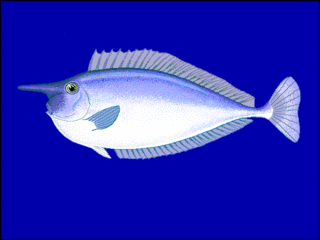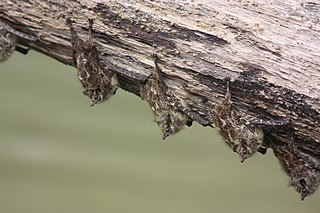
Naso is a genus of fish in the surgeonfish family, Acanthuridae. Fish of this genus are known commonly as unicornfishes because of the "rostral protuberance", a hornlike extension of the forehead present in some species. Unicorn fish are popular with spearfishermen and may be cooked by grilling them whole. Unicornfish primarily live around coral reefs and eat mostly algae as well as roshi (flour) in Maldives. It is very popular in Maldives.

http://www.sicily.co.uk/wp-content/uploads/Naso-DWKCKW.jpg

The long-nosed mongoose is a mongoose native to Central African wetlands and rainforests. It has been listed as Least Concern on the IUCN Red List since 1996.

The proboscis bat is a bat species from South and Central America. Other common names include Long-nosed proboscis bat, sharp-nosed bat, Brazilian long-nosed bat and river bat in English, and murciélago narizón in Spanish. It is monotypic within its genus.

The long-eared jerboa is a nocturnal mouse-like rodent with a long tail, long hind legs for jumping, and exceptionally large ears. It is distinct enough that authorities consider it to be the only member of both its genus, Euchoreutes, and subfamily, Euchoreutinae.
The Flores long-nosed rat, also known as Paula's long-nosed rat, is a species of rodent endemic to Flores Island, Indonesia. This species was first described from subfossil fragments collected in the 1950s by Theodor Verhoeven, who named it Paula's long-nosed rat, and was named Floresomys naso by Guy Musser in 1981. Since Floresomys was preoccupied, Musser changed the name to Paulamys, after Verhoeven's life partner Paula Hamerlinck. A living specimen was reported from the montane forest of western Flores in 1989. It is recorded as common between 1,000 and 2,000 m above sea level on the volcanic mountain Gunung Ranakah, but is believed to be threatened by habitat destruction. It is the only known member of the genus Paulamys. The genera Papagomys, Komodomys and Paulamys are closer related to each other than to other murids, suggesting an adaptive radiation.
The Sulawesian shrew rat is a species of rodent in the family Muridae. It is the only species in the genus Melasmothrix. It is found only in central Sulawesi, Indonesia, and is known from the localities of Rano Rano and Mount Nokilalaki.

Kurixalus naso is a species of frog in the family Rhacophoridae. It is found in northeastern India, Tibet, and Myanmar. Its natural habitats are subtropical or tropical dry forests, subtropical or tropical moist montane forests, subtropical or tropical moist shrubland, subtropical or tropical seasonally wet or flooded lowland grassland, and intermittent freshwater marshes. It is threatened by habitat loss.

The long-nosed dasyure is a species of marsupial in the family Dasyuridae. It is found in Indonesia and Papua New Guinea. Its natural habitat is subtropical or tropical dry forests.

The short-nosed unicornfish is a species of unicornfish in the family.

Naso lituratus is a species of fish in the family Acanthuridae, the tangs and unicornfishes. Its common names include barcheek unicornfish, naso tang, and orange-spine unicornfish.

Cirrhinus mrigala is a species of ray-finned fish in the genus Cirrhinus. It is found in northern India, Pakistan, Bangladesh and Nepal. This species and the Mrigal carp are both considered distinct.
The long-nosed paramelomys is a species of rodent of the family Muridae endemic to New Guinea. It is found in the lowlands of the south of the country.

Suresh Bhattarai is a Nepalese Physicist, Astrophysicist who is a physics lecturer at the Department Of Physics at Tri-Chandra Multiple Campus and also is the Current Chairperson Of Nepal Astronomical Society (NASO)..He was the chartered secretary of Nepal Astronomical Society (NASO) (2007-2014) .He was the National Point of Contact for Space Generation Advisory Council (SGAC) (2009-2013), SGAC office executive secretary for Vienna, Austria (2011-2013). At Tri-Chandra Multiple Campus, he mainly guides students in laboratory works as well as supervises Final year Undergraduate Students in their research projects on Physics, Astronomy, Astrophysics and Space Science.
Aulobaris anthracina is a species of flower weevil in the beetle family Curculionidae. It is found in North America.
Aulobaris is a genus of flower weevils in the beetle family Curculionidae, with about eight described species.

Xyonysius is a genus of seed bugs in the family Lygaeidae. There are about 10 described species in Xyonysius.

Megalocoleus is a genus of plant bugs in the family Miridae. There are about 18 described species in Megalocoleus.
Aulobaris dux is a species of flower weevil in the beetle family Curculionidae. It is found in North America.

The Executions of Kokkinia took place on the August 17, 1944, and was the largest Nazi roundup and one of the largest-scale war crimes perpetrated during the German occupation of Greece. The operation was carried out by members of the Luftwaffe and collaborationist Security Battalions, and involved the execution of hundreds of civilians, thousands of hostages being sent to concentration camps, and the burning down of entire house blocks, as well as significant atrocities.













